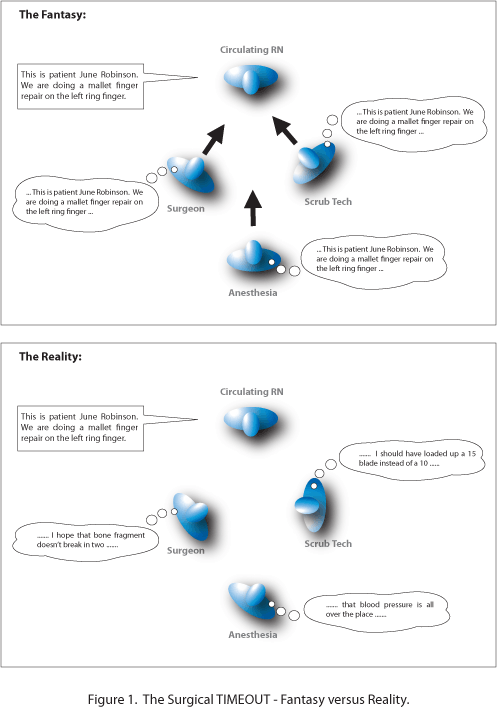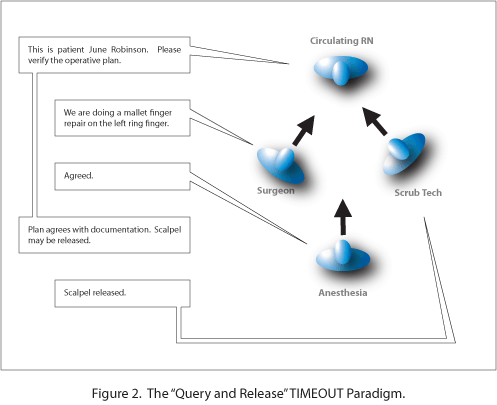The following article is written by Stephen Lober, MD, director of research and development, and Sean Berry, MPA, RN, CNO, clinical director, for OP-marks.
The surgical time out is now a standard component of the Universal Protocol for the prevention of wrong-site surgeries. In theory, it represents the last firewall between the patient and an untoward surgical mishap, acting as a final confirmation amongst the entire surgical team regarding what is about to transpire surgically. Unfortunately, if performed incorrectly, it can digress into a ritual that merely "goes through the motions."
As practiced in many hospitals, the surgical time out consists of the circulating nurse reading aloud the name of the patient, the planned surgical procedure(s) and operative site(s), any pertinent allergies and an ever growing list of items to be checked off immediately prior to the initiation of surgery. The surgeon commonly signifies agreement with either a verbal "yes" or a simple nod of the head. Anesthesia may do the same. The scrub tech more commonly is a silent participant in the process.
The fantasy of this particular version of the surgical time out is that everyone is devoting their full attention to what is being verbalized by the circulating nurse. Unfortunately, this may or may not match the reality of what is actually occurring (Fig. 1). In reality, it is not uncommon for the surgeon's attention to already be focused on the next phase of the procedure. Furthermore, it is not uncommon for the scrub tech's attention to be focused on the surgeon, not the circulating nurse. In other words, there is no guarantee that the participants are actually participating fully in the process.
Sign up for our FREE E-Weekly for more coverage like this sent to your inbox!
This potential flaw in the time-out process as described above is revealed by a case of wrong-site surgery:
Case example
R.W. is a 27-year-old male who sustained deep second degree scald burns to his entire right hand when a cap blew off of a car radiator he was working on. The cap also hit the tip of his right ring finger, causing a violent hyperextension of his distal phalangeal joint and a closed mallet deformity. He is taken to the operating room for a planned open repair of the extensor avulsion. In the pre-operative holding area, the patient is appropriately seen by his surgeon. Because the patient's hand is in a bulky burn dressing and because of concerns for the patient's comfort, the surgeon initials the correct extremity immediately above the dressings, at the level of the wrist. In the operating room, a standard time out is conducted wherein the circulating nurse clearly verbalizes that a right ring finger extensor tendon repair is to be performed. The operating surgeon, already running far behind in schedule, impatiently nods in agreement, then proceeds to make a surgical incision overlying the dorsal surface of the middle finger. The error is immediately identified by all involved. Nevertheless, the error has already occurred in spite of what, on the surface, was a standard time-out process.
Although a number of errors conspired to eventually culminate in this case of wrong-site surgery (as is almost invariably the case), the intrinsic flaw in the time-out system is clearly exposed. The correct finger was identified by the time-out process (as verified by others in the room), the surgeon signified agreement with a verbal affirmative, and then proceeded to make an incision on the wrong finger. Did the time out serve its intended purpose in this case? No. Was the surgeon fully engaged in the time-out process as executed? Apparently not.
In interviewing a large number of surgeons and OR personnel regarding the time-out process as practiced above, a number of very useful observations were made:
Surgeon's perspective
All surgeons are obviously interested in providing their patients with the best care possible. It is no secret, however, that far too many surgeons still consider the entire surgical site marking process to be a burdensome chore that was instituted to protect patients from "bad" surgeons, and not from them. They themselves would never "do something as stupid" as operating on the wrong body part or performing the wrong procedure. This can lead to indifference and even outright obstinacy when it comes to executing the time-out process. Failure to realize that this can and will lead to eventual failures in the system if not adequately accounted for.
Circulating nurse's perspective
In many hospitals, the burden of conducting the time-out process is placed squarely upon the shoulders of the circulating nurse. During this period, the circulating nurse should be the center of everyone's attention. Ideally, there should be absolute quiet in the room (similar to the "sterile" cockpit environment in a commercial airliner during takeoff), and nothing else should be going on that might distract the participants' attention.
This is not always the case, according to the experiences of many of the circulating nurses interviewed. A not uncommon complaint was that they occasionally were forced to "talk over" the background noise in the room during the time-out process. And while the majority of time outs were being performed in a collegial fashion, it was also not uncommon for the nurses to perceive that it was not being taken seriously by all of the participants. Finally, an almost universal complaint was that more and more items are being "piled on" to the time-out process itself and that too much faith is now being placed in the ability of the process to catch any and all errors at literally the very last second.
Scrub tech's perspective
A surprisingly large number of the scrub techs interviewed identified themselves as being "innocent bystanders" in the time-out process rather than active participants. In general, most did not identify the site-marking process as being part of their job. Particularly disturbing was the finding many scrub techs did not feel entirely comfortable stopping a procedure even if they thought that a surgical mistake was about to be made.
Anesthesiologist's/anesthetist's perspective
All anesthesiologists and anesthetists felt that they needed to be active participants in the time-out process, and none were opposed to conducting the time-out process itself. Furthermore, all felt fully empowered to stop the surgical procedure if a discrepancy was encountered. As a group, they were clearly the least deferential with regard to "standing up to the surgeon" if the need were to arise.
In terms of actually running the time-out process itself, there was only one concern, but it was a very important one. While running the time out would "not be a problem 98 percent of the time," there were admittedly instances such as difficult intubations, difficult inductions and hemodynamically unstable patients during which times the anesthesiologists/anesthetists thought that someone else should be conducting the time out. This would necessitate unwanted exceptions to the rule.
"Query and release" timeout paradigm
There are clearly intrinsic flaws in the time-out process as currently practiced in most hospitals today. It is commonly conducted by different personnel in different hospitals, and in different formats, even within the same institutions. Furthermore, the manner in which it is executed does not adequately account for the all-too-human foibles of distraction, complacency, and indifference.
The time-out process should maximally engage its participants. It should not expect the participants to be paying full attention. It should be designed to ensure that the participants are paying full attention. The following "query and release" time-out paradigm (Fig. 2) is suggested as a better method of accomplishing this:
1) The time out should be conducted immediately prior to the first invasive action taken on the patient (anesthetic injection or skin incision). It should be conducted in a "sterile" OR environment, with absolutely no extraneous talking or activities.
2) The circulating nurse should conduct the time out. The circulating nurse has access to all of the pertinent paperwork and can run the time out effectively 100 percent of the time. Anesthesia can run the time out effectively 98 percent of the time, which is not adequate for establishing a truly universal system.
3) The surgeon should be challenged by the circulating nurse with a simple query as to the exact operative plan.
4) The Surgeon must verbalize the operative plan correctly, including procedure(s) and site(s), before the surgery can progress. A cursory "yes" or nod of the head simply does not ensure adequate engagement in the process.
5) Anesthesia should confirm its agreement.
6) The circulating nurse should then confirm agreement with the pertinent paperwork and give a verbal release to the scrub tech that the scalpel (or syringe) can be made available for commencement of the procedure.
7) Only upon receiving the circulating nurse's verbal release should the scrub tech make the scalpel (or syringe) available for use by the Surgeon.
Much emphasis has been rightfully placed on the surgeon seeing and talking to the patient preoperatively, and initialing the correct operative site(s). This ensures that the surgeon is intimately engaged in the actual site-marking process. The very same arguments can be made for the surgeon's participation in the time-out process as well. Engaging the surgeon with a query and requiring one last deliberate response to that query ensures active participation over and above a simple "yes" or a nod of the head.
If our systems of quality control do not take human weaknesses into account, they will fail us. It is naive to think that complacency, distraction, disinterest, and even carelessness do not occur. They do. And we are obligated to do our best to minimize their effects. The query and release time-out paradigm will arguably provide our patients (and ourselves) with greater protection against lapses in otherwise excellent patient care. The time out is clearly worth doing, and it is worth doing right.


Learn more about OP-marks.
Related Articles on the Time-Out Process:
Patient Safety Tool: Time-Out Stop Sign Poster
Guidance to Prevent Adverse Events in Surgery Centers: Wrong-Site Surgery
6 Steps to Prevent Wrong-Site Surgery

